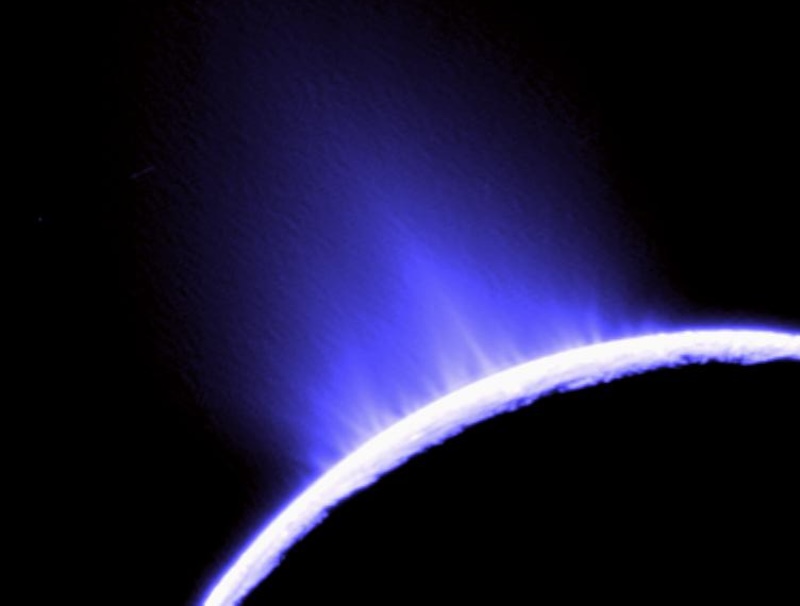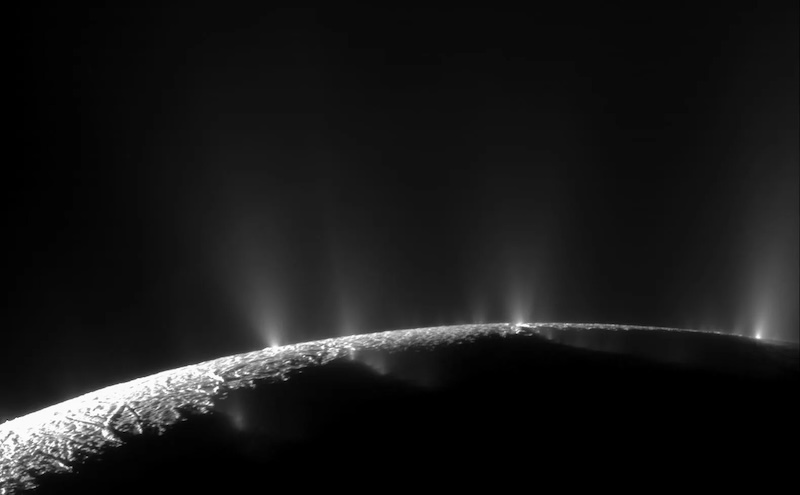
- Previously undetected sub-micrometer particles have now been identified in the water vapor plumes of Saturn’s moon Enceladus.
- The plumes gush from cracks in the ice on Enceladus’ surface, suggesting a liquid ocean within this moon’s interior.
- The newly detected particles are in the same size range as some earthly bacteria, specifically those that live near hydrothermal vents in Earth’s oceans. Scientists say that Enceladus’ seafloor could have similar vents.
Sub-micrometer particles identified in Enceladus’ plumes
Enceladus is an intriguing little world, with a global ocean of salty water beneath its outer ice crust. Could there be life in this alien ocean? NASA’s Cassini spacecraft flew through and sampled the water vapor plumes that erupt through cracks in Enceladus’ icy surface. The spacecraft found a variety of organic compounds in the plumes. Now, three scientists in Poland say that Cassini may have discovered evidence for microorganisms. In late March, 2024, they described evidence of sub-micrometer-sized particles in the Cassini data of the plumes. Intriguingly, the size of the particles is consistent with some bacteria found around hydrothermal vents on seafloors on Earth.
The researchers published their peer-reviewed paper in the January-March issue of the journal Pomiary Automatyka Robotyka (PAR). The paper is also available on arXiv (March 23, 2024).
Jan Kotlarz and Katarzyna Kubiak are two of the researchers, at Lukasiewicz Institute of Aviation in Warsaw, Poland. Natalia Zalewska is the other researcher, at the Space Research Center of the Polish Academy of Sciences in Warsaw, Poland.
Sampling the plumes on Enceladus
Cassini’s historic mission to Saturn and its moons ended in 2017. And, as might be expected, Cassini studied Enceladus repeatedly during multiple flybys.
The plumes erupt through large cracks in the icy crust at the South Pole called Tiger Stripes. Salty water from the ocean below makes its way up through the cracks and spews into space. In fact, Cassini actually flew through some of these plumes and sampled them directly. And, although its instruments weren’t designed to detect life itself, they did find many tantalizing clues about how habitable the ocean might be.
The ocean is similar to the ocean in the Antarctic covered by ice sheets. There are organic compounds, the building blocks of life, in the ocean as well. Cassini also found evidence for active hydrothermal vents on the seafloor. On Earth, those vents provide heat and mineral nutrients for a variety of life forms deep in the oceans.

Spectral analysis of Enceladus’ plumes
Cassini used its Ultraviolet Imaging Spectrograph (UVS) instrument to study particles in Enceladus’ plumes. The research team then later used ultraviolet spectral analysis and Mie solutions to identify and estimate the sizes of the new particles. The paper said:
Estimating particle size distribution on spectral data analysis is a common practice. One method is to compare the observed brightness of the scattering molecules with the Mie solutions of light scattering for Maxwell’s equations.
To describe the sub-micrometer particle size distribution in Enceladus plumes, we used ultraviolet hyperspectral data collected by the Cassini probe in 2009. Using this data, we calculated the ratio of the Saturn’s signal disturbed by the Enceladus transit to the Saturn’s pure signal. Then, using Mie solutions of Maxwell’s equations, we estimated effective cross-sections for particles with diameters between 10 nm and 2 um (micrometer). Effective cross-sections were estimated for 1024 UV wavelengths measured by Cassini UVIS.
Using the gradient-descent method, we estimated particle diameter distribution in plumes assuming that the modeled ratio of the disturbed to undisturbed signal should coincide with the spectrum observed by UVIS.
The paper itself goes into more technical detail as to how the particle sizes were determined.
Sub-micrometer particles reminiscent of bacteria
All of that is exciting and could point to Enceladus being not only geologically alive, but biologically as well. Cassini’s instruments couldn’t positively identify actual microbes, or pieces thereof, in the plumes. But what the three Polish scientists said they found in the data is interesting: sub-micrometer particles with diameters of 120–180 nm and 240–320 nm. These are consistent with three types of earthly bacteria in particular – Thermofilum, Thermoproteus and Pyrobaculum – that inhabit hydrothermal vents on Earth.
Also, previous studies had found ice particles in the plumes as small as < 0.4 um (micrometer). One um is a millionth of a meter. Scientists say those particles formed in the plume itself. Larger ice grains, however, came from the bottom of the ocean. As the researchers noted, particles smaller then 0.5 um are also similar to the size of single-celled bacteria that live in hydrothermal vents in Earth’s oceans:
Particles smaller than 0.5 um correspond to the size of single cells of thermophilic bacteria and archaea living inside Earth’s hydrothermal vents with temperatures near 80 °C. Thermophilic cells are smaller than typical 1–2 um microorganisms. The smallest cell sizes recognized in hyperthermophilic archaea are 0.17 um in diameter (Thermofilum sp.), 0.3 um in diameter (Thermoproteus sp. and Pyrobaculum), or disks 0.2–0.3 um in diameter and 0.08–0.1 um wide in Thermodiscus and Pyrodictium. The presence of methanogens in the ocean of Enceladus would result in the presence of particles in water plumes of sub-micrometer size, consistent with the diameter of the cells.
Is this evidence of life on Enceladus?
The results are intriguing, although not definitive yet. To be sure, more analysis is required to further determine just what the particles might be. Are they organic or something else? If they aren’t organic – composed of molecules known to be building blocks of life – then they can’t be cells as we know them on Earth. But if they are, then the possibilities become more interesting, indeed. Cassini discovered organic molecules on their own in the plumes before. Their origins could be either biological or non-biological. These newly-identified particles, however, are the right size to potentially be cells, whether living or dead.
As planetary astronomer Franck Marchis posted on X:
Three scientists from Poland have discovered two populations of sub-micron particles in Enceladus' hydrothermal vents, suggesting possible microbial life. Have we stumbled upon extraterrestrial life within our solar system through UV scattering? More observations of occultation… https://t.co/K3WnPS5BYe pic.twitter.com/z5alDX7t6x
— Franck Marchis (@AllPlanets) March 27, 2024
If the particles are biological, then the researchers speculate that they could be methanogens, microbes that produce methane. In 2021, scientists said that they found evidence of methane in the plumes, a surprising amount of it, in fact. This still isn’t proof of life yet, but methanogenic microbes do inhabit seafloor hydrothermal vents on Earth.
Comparison with bacteria from geysers on Earth
The paper concluded:
The main goal of our work was to confirm the presence of the sub-micrometer particles using far-ultraviolet part of the Cassini Ultraviolet Imaging Spectrograph Subsystem (UVIS) spectrum acquired during Enceladus passing in front of their parent planet in 2009 and compare results with known methanogenic archaea and bacteria sizes investigated by taking samples from hot (up to 80 °C) geysers on the Earth.
The result best-fit estimation of sub-micrometer particle diameters distribution give us two types of particles: characterized by diameters of 120–180 nm and 240–320 nm. Besides these two types we can see particles with diameters up to 1 um with a population of about 10–20 times lower than two main components. Also the micrometer-size particles discovered in many studies are present in our result.
The need expressed by Bedrossian et al. in 2017 that “detection of extant microbial life requires the ability to identify and enumerate micrometer-scale, essentially featureless cells” could be satisfied by ultraviolet measurement done by occultations.
Bottom line: A new study of Cassini data has revealed bacteria-sized particles in the plumes of Saturn’s ocean moon Enceladus. Could they be evidence of microbial life?
Read more: Watery plumes on Enceladus could hold signs of life
Read more: Enceladus’ ocean even more habitable than thought











